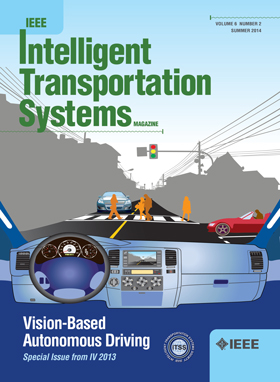Expressway Traffic Trajectory Recognition on DAS Vibration Spatiotemporal Images
IF 7.9
1区 工程技术
Q1 ENGINEERING, CIVIL
IEEE Transactions on Intelligent Transportation Systems
Pub Date : 2025-02-21
DOI:10.1109/TITS.2025.3540540
引用次数: 0
Abstract
Distributed Acoustic Sensing (DAS) can capture spatio-temporal vibration images of vehicles on expressways, which can be utilized for traffic monitoring. Compared to ubiquitously deployed cameras, DAS traffic monitoring offers advantages such as full coverage, resistance to environmental interference, low computational requirements, and cost-effectiveness. However, real-world complexities result in challenges for DAS traffic images, including low signal-to-noise ratio, signal missing, and uneven intensity. As DAS traffic applications are still in their early stages, effective solutions to these challenges are yet to be developed. This paper proposes a new deep learning method named DAS High Speed Traffic Trajectory (DAS-HTT) network, which contributes threefold: (i) Multi-Scale Context Extraction Module (MSCE) effectively enlarges the receptive field to capture long-range contextual information comprehensively; (ii) Stripe Convolution Decoder (SCD) acquires remote information along four directions, preventing irrelevant region interference in feature learning; (iii) Hierarchically Hough Transform Fusion Decoder (HHTFD) introduces the structural information of trajectory linearity, reducing the reliance on label data while enhancing trajectory continuity. We conducted experiments on an operating expressway, demonstrating that DAS-HTT outperforms existing methods across seven metrics, providing trajectories that are more consistent with ground truthes.基于DAS振动时空图像的高速公路交通轨迹识别
分布式声传感技术(DAS)可以捕获高速公路上车辆的时空振动图像,用于交通监控。与无处不在的摄像机相比,DAS交通监控具有全覆盖、抗环境干扰、低计算需求和成本效益等优势。然而,现实世界的复杂性给DAS交通图像带来了挑战,包括低信噪比、信号缺失和强度不均匀。由于DAS交通应用仍处于早期阶段,因此尚未开发出有效的解决方案来应对这些挑战。本文提出了一种新的深度学习方法DAS高速交通轨迹(DAS- htt)网络,该方法有以下三个方面的贡献:(1)多尺度上下文提取模块(MSCE)有效地扩大了感知场,以全面捕获远程上下文信息;(ii)条纹卷积解码器(SCD)沿四个方向获取远程信息,防止特征学习中不相关区域的干扰;(iii)分层霍夫变换融合解码器(htfd)引入了轨迹线性度的结构信息,减少了对标签数据的依赖,同时增强了轨迹的连续性。我们在一条正在运营的高速公路上进行了实验,证明DAS-HTT在七个指标上优于现有方法,提供的轨迹更符合地面真实情况。
本文章由计算机程序翻译,如有差异,请以英文原文为准。
求助全文
约1分钟内获得全文
求助全文
来源期刊

IEEE Transactions on Intelligent Transportation Systems
工程技术-工程:电子与电气
CiteScore
14.80
自引率
12.90%
发文量
1872
审稿时长
7.5 months
期刊介绍:
The theoretical, experimental and operational aspects of electrical and electronics engineering and information technologies as applied to Intelligent Transportation Systems (ITS). Intelligent Transportation Systems are defined as those systems utilizing synergistic technologies and systems engineering concepts to develop and improve transportation systems of all kinds. The scope of this interdisciplinary activity includes the promotion, consolidation and coordination of ITS technical activities among IEEE entities, and providing a focus for cooperative activities, both internally and externally.
 求助内容:
求助内容: 应助结果提醒方式:
应助结果提醒方式:


